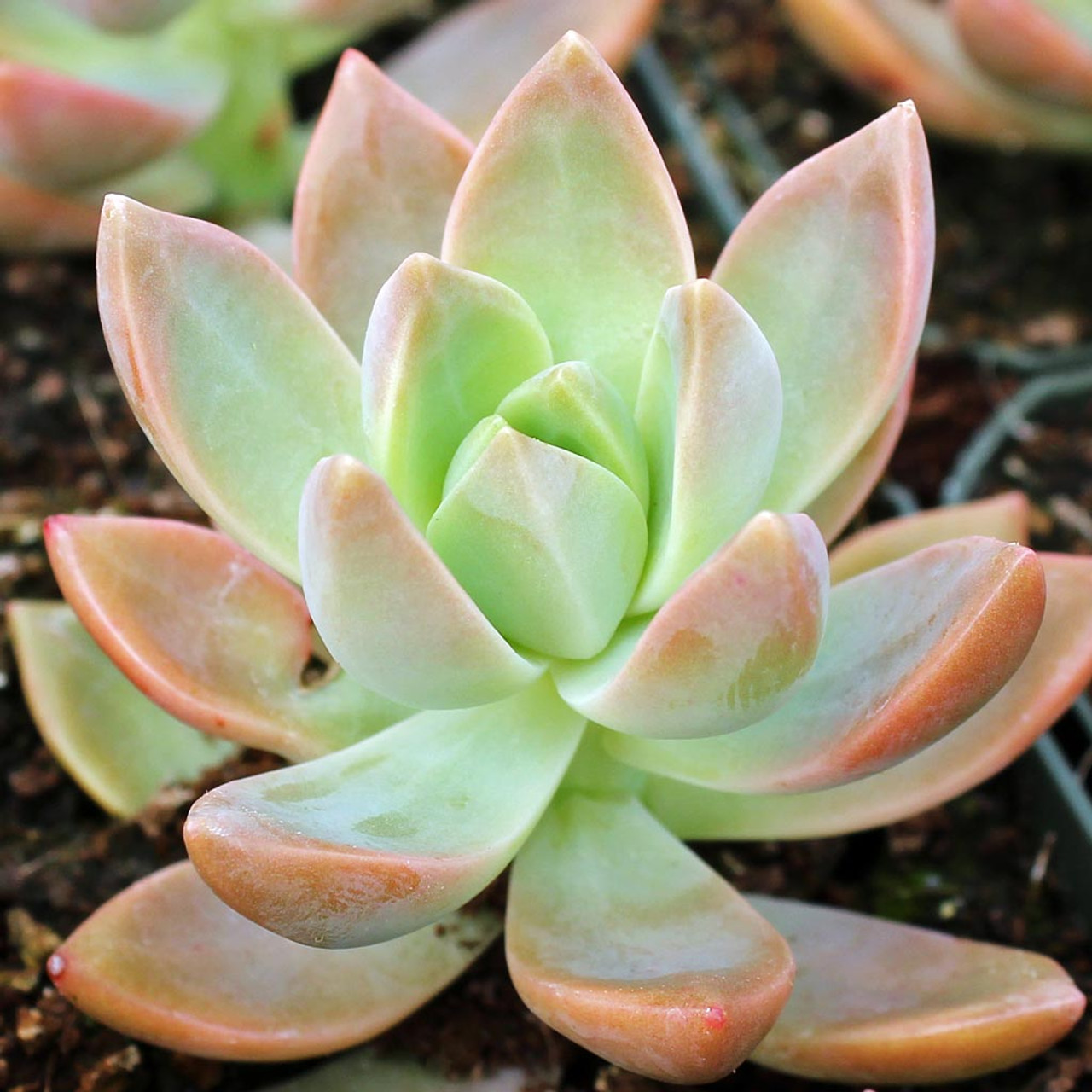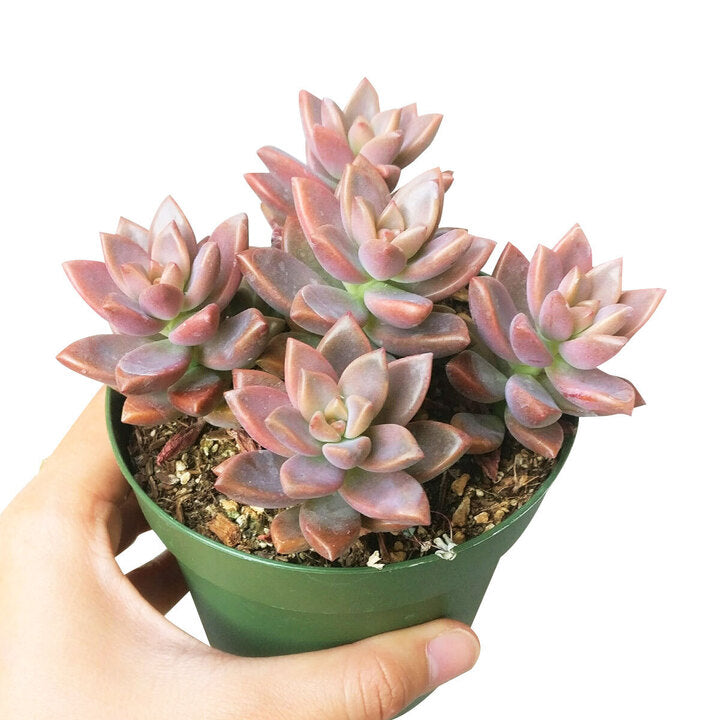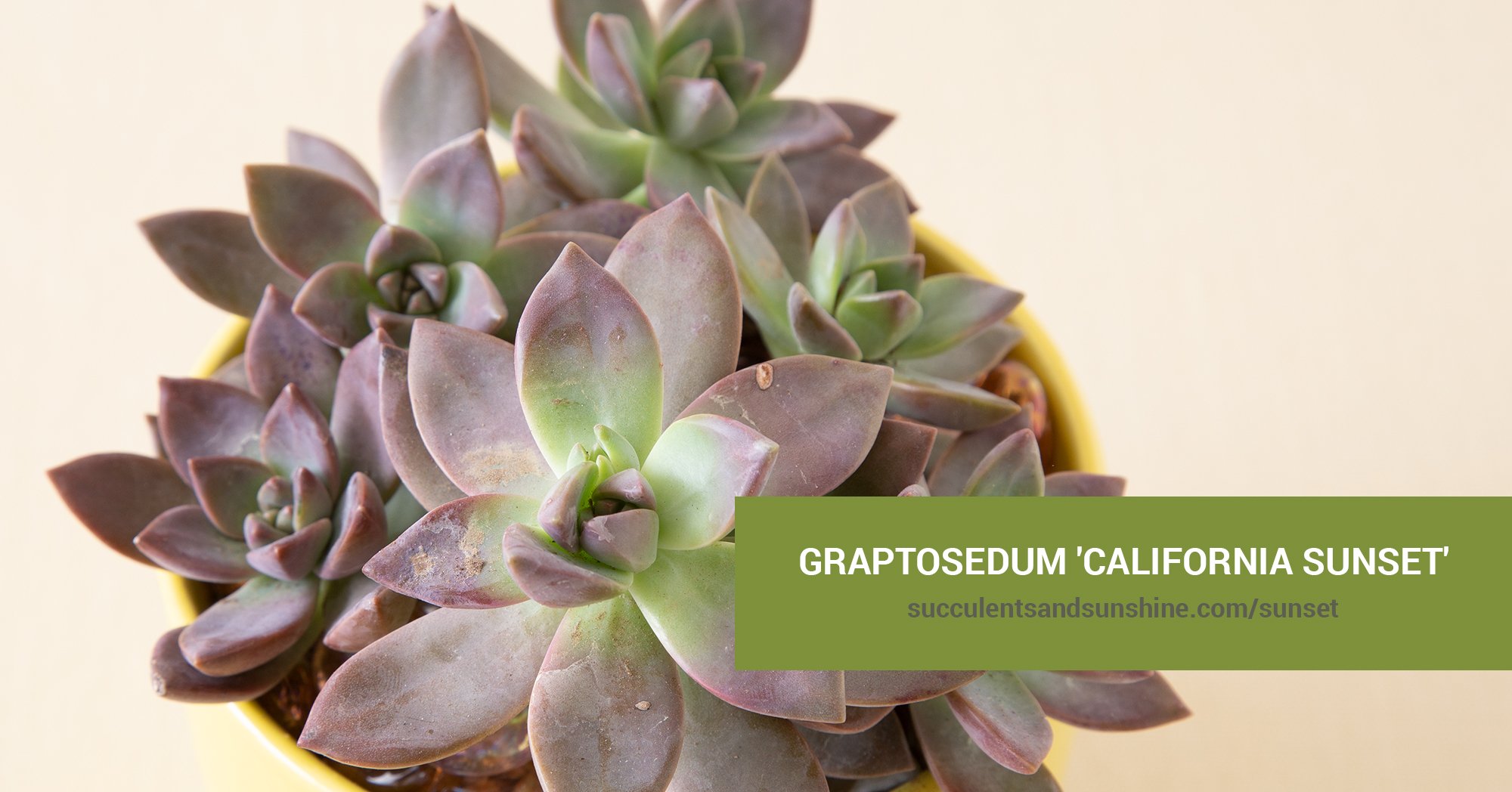This succulent is characterized by its thick, reddish-colored leaves that form into a rosette shape. It is similar to Echeveria and can be easily propagated by leaf. During the Spring season, small white flowers will bloom.
Table of Contents
Care and Propagation Information
Graptosedum ‘California Sunset’ is a well-liked succulent variety among collectors. It is a hybrid of two other succulents – Graptopetalum paraguayensis, also known as the “Ghost Plant”, and Sedum adolphii. The reddish leaves of this variety provide a nice contrast when used in succulent arrangements or rock gardens.
Watering
To ensure optimal health for a California Sunset succulent, the “soak and dry” method of watering is recommended. Allow the soil to dry out completely between waterings for best results.
Where to Plant
If you are located in an area with colder temperatures (below 30° F/-1.1° C) than it is recommended to keep Graptosedum ‘California Sunset’ in a pot that can be brought indoors. This succulent does best when it receives full to partial sun and should be placed in a spot where it will have access to at least 6 hours of sunlight each day.
How to Propagate Graptosedum ‘California Sunset’
Graptosedum ‘California Sunset’ can be propagated in multiple ways, including from leaves, cuttings, seeds, and offsets.
Leaves
To ensure successful propagation, carefully twist a leaf from the stem when taking it for propagation. Ensure that the leaf you take comes off in one piece, with no part of the leaf remaining on the stem. This will give you the best chance of successful leaf propagation.
Let the leaf heal for a couple of days before setting it in soil that drains well.
Cuttings
To propagate Graptosedum ‘California Sunset,’ use a sterile, sharp cutting tool to snip off a leaf from the main plant. Allow the leaf to dry and form a callous before planting the cut end in a well-draining soil. Keep the soil moist but not wet, letting it dry out completely between waterings.
Seeds
When growing ‘California Sunset’ from seed, it’s important to make sure the environment is warm, either naturally or with the help of a grow light and seed warmer. Plant the seeds in soil that drains well and water it whenever it becomes dry. Depending on the growing conditions, germination could take several weeks or even longer.
Offsets
Graptosedum ‘California Sunset’ can be propagated by cutting off the small rosette offsets from the main stem with a clean, sharp knife or scissors. Let the offsets dry for a period of one to two days before placing them on soil that has good drainage.
Care and Propagation Information
General Care for Graptosedum ‘California Sunset’
Watering
To ensure optimal health for a California Sunset succulent, the “soak and dry” method of watering is recommended. Allow the soil to dry out completely between waterings for best results.
Where to Plant
If you are located in an area with colder temperatures (below 30° F/-1.1° C) than it is recommended to keep Graptosedum ‘California Sunset’ in a pot that can be brought indoors. This succulent does best when it receives full to partial sun and should be placed in a spot where it will have access to at least 6 hours of sunlight each day.
How to Propagate Graptosedum ‘California Sunset’
Graptosedum ‘California Sunset’ can be propagated in multiple ways, including from leaves, cuttings, seeds, and offsets.
Leaves
To ensure successful propagation, carefully twist a leaf from the stem when taking it for propagation. Ensure that the leaf you take comes off in one piece, with no part of the leaf remaining on the stem. This will give you the best chance of successful leaf propagation.
Let the leaf heal for a couple of days before setting it in soil that drains well.
Cuttings
To propagate Graptosedum ‘California Sunset,’ use a sterile, sharp cutting tool to snip off a leaf from the main plant. Allow the leaf to dry and form a callous before planting the cut end in a well-draining soil. Keep the soil moist but not wet, letting it dry out completely between waterings.
Seeds
When growing ‘California Sunset’ from seed, it’s important to make sure the environment is warm, either naturally or with the help of a grow light and seed warmer. Plant the seeds in soil that drains well and water it whenever it becomes dry. Depending on the growing conditions, germination could take several weeks or even longer.
Offsets
Graptosedum ‘California Sunset’ can be propagated by cutting off the small rosette offsets from the main stem with a clean, sharp knife or scissors. Let the offsets dry for a period of one to two days before placing them on soil that has good drainage.
FAQ
What is the hardiness zone for graptosedum California sunset?
It is best to keep the plant in a location that receives ample sunlight and is not exposed to frost, as it is not frost-tolerant. The USDA hardiness zone for this plant is between 10a and 11b, which is between 30° and 50° degrees Fahrenheit (-1° and 10° Celsius).
What hardiness zone is California Sunset succulent?
Graptopetalum is a drought tolerant succulent that grows best in well-drained spots with some sunlight to partial shade. It is hardy in zones 10, but if you live in a cooler climate you should consider growing it in a pot that can be brought indoors during the winter.
What is Echeveria California sunset?
This succulent plant, Crassula ovata, has echeveria-like rosettes on decumbent stems. Its leaves are a distinctive copper gold with yellow, green and pink overtones, and during the spring and summer months it is adorned with white crassula-like star-shaped flowers.
How do you care for California Sunset succulents?
Paraphrase: – Light: Put the plant in an area of your home or office that gets a lot of direct sunlight.
– Watering need: Allow all of the soil to dry out before watering.
– Fertilizing need: Only fertilize when needed.
– Get the Planta app to get personalized care instructions.
How big do California sunset succulents get?
‘California Sunset’ is an ideal succulent for growing in containers or rock gardens, as it stands 6-8 inches tall and stretches up to 8 inches wide. Its light green foliage has peach-colored tips, and the more it is exposed to various stressors, the more vibrant the colors become.



